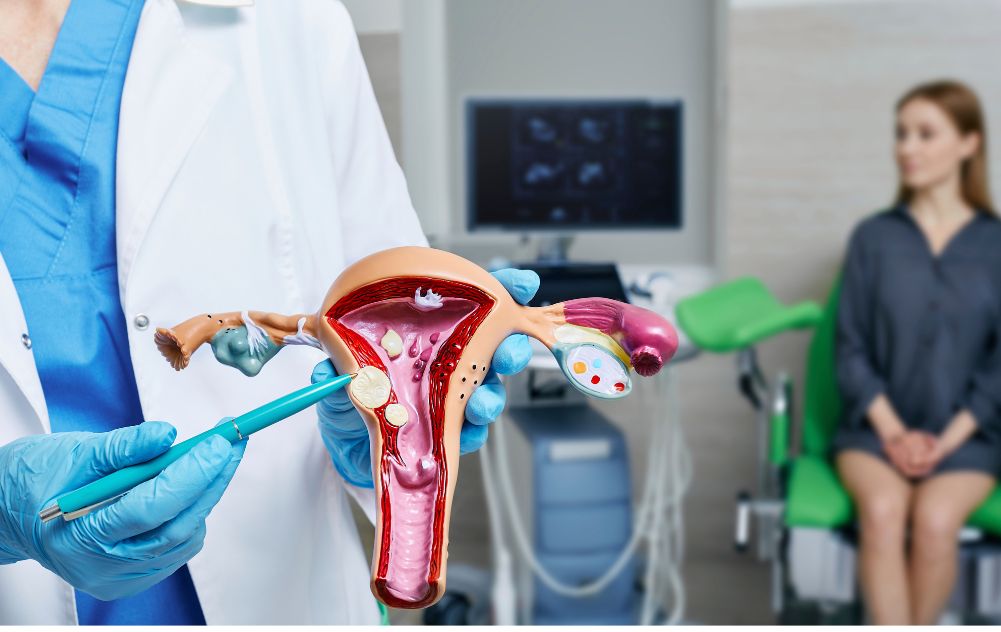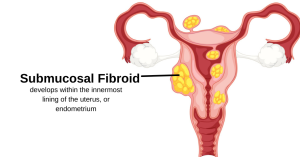
Fibroid expulsion happens when a fibroid is naturally pushed out of the uterus through the cervix and into the vaginal canal. This is more common with submucosal fibroids, which grow just beneath the inner lining of the uterus. Expulsion can occur spontaneously or after certain treatments but is a rare occurrence.
Below, we share important information about fibroid expulsion after UFE. If you have additional questions, our leading fibroid specialists are available to answer them.
Meet with a fibroid specialist
What does Fibroid Expulsion Feel Like?
Fibroid expulsion can feel different for each person, but common sensations and symptoms include:
-
Sudden Pelvic Pressure or Fullness: You may feel a heavy or bulging sensation in the pelvic area or vagina, similar to needing to pass something.
-
Intense Cramping: Cramping may be stronger than a typical period, sometimes described as labor-like pain as the uterus contracts to push out the fibroid.
-
Heavy Bleeding: Many women experience a sudden increase in bleeding, sometimes with clots or tissue.
-
Passing Tissue: You may actually feel or see tissue passing through the vagina. It may resemble a large clot or a fleshy mass.
-
Foul-Smelling Discharge: If the fibroid tissue remains in the uterus for too long, it can begin to break down and cause an odor.
-
Relief After Expulsion: Some women report an immediate reduction in pressure or discomfort once the fibroid has passed.
Can Fibroids Pass During My Period?
It’s rare, but in some cases, a fibroid can be expelled from the uterus, typically during or just after your period. This usually happens with submucosal fibroids—those that grow just beneath the uterine lining. As the uterus contracts during menstruation, it may push the fibroid out, especially if it’s small and located near the cervical opening.
Signs of fibroid expulsion may include unexpected heavy bleeding, severe cramping, a feeling of pressure in the vagina, or even passing tissue. If you think you’ve passed a fibroid, it’s important to contact your doctor right away for an evaluation and to rule out complications like infection or incomplete expulsion.
Are Fibroids Expelled After UFE?
If you are considering UFE treatment, you may be concerned about fibroid expulsion. Fibroid expulsion is considered a rare complication of Uterine Fibroid Embolization. It only occurs in 1-10% of cases.
To better understand why fibroid expulsion after UFE can occur, it may be helpful to discuss how this non-invasive treatment works.
During UFE treatment:
- We provide a light sedative and local anesthesia so that you can remain calm and comfortable the entire time
- Our fibroid specialists locate your fibroids using advanced ultrasound technology
- Next, we numb your upper thigh, make a small incision, and insert a tiny catheter
- Using real-time imaging, we guide the catheter into the uterine artery that supplies blood to fibroids
- Finally, we inject embolic materials into the artery to block the blood flow to your fibroids
In most cases, targeted fibroids begin to shrink once cut off from their blood supply and detach from the uterine wall. Fibroid tissue is then naturally absorbed by the body over time. In rare cases, the body instead expels the tissue. This is a sign that the treatment is working, but follow-up care is important to monitor healing.
If you believe you are experiencing fibroid expulsion, we recommend contacting your fibroid specialist.
SCHEDULE A FIBROID CONSULTATION TODAY
What Should You Know About Fibroid Expulsion After UFE?
Fibroid expulsion is most likely to occur within three months of UFE. Submucosal fibroids, or fibroids located within the innermost lining of the uterus, present the greatest likelihood of post-UFE expulsion.

It is also important to know that surgery is sometimes necessary after fibroid expulsion if the involved fibroid remains partially attached to the uterus. Another potential reason for surgery is if a severe infection develops that doesn’t respond to antibiotics.
If you have concerns about complications following UFE, we encourage you to raise them with your fibroid specialist.
What Is Fibroid Expulsion Discharge?
During and after fibroid expulsion, vaginal discharge may be present. This can develop as a result of natural expulsion or expulsion after UFE. Along with fibroid expulsion discharge, some women pass pieces of fibroid tissue or a complete expelled fibroid.
If you are experiencing discharge that has an unpleasant odor, contact your doctor immediately, as this may indicate infection.
Learn More About Fibroid Expulsion at USA Fibroid Centers
At USA Fibroid Centers, we understand that choosing the best fibroid treatment for your unique situation can be challenging. We care about your quality of life and are available to help you explore your full range of treatment options.
Our specialists perform Uterine Fibroid Embolization, a minimally invasive, outpatient fibroid treatment that can quickly alleviate fibroid symptoms like heavy bleeding, severe cramps, frequent urination, and low energy levels. UFE does not involve surgery, a hospital stay, or lengthy recovery. Most women can return to normal daily activities within one to two weeks.
To explore your full range of treatment options, request a consultation with one of our leading fibroid specialists online. We offer expert fibroid care in dozens of treatment centers across the USA, along with convenient telemedicine options.


